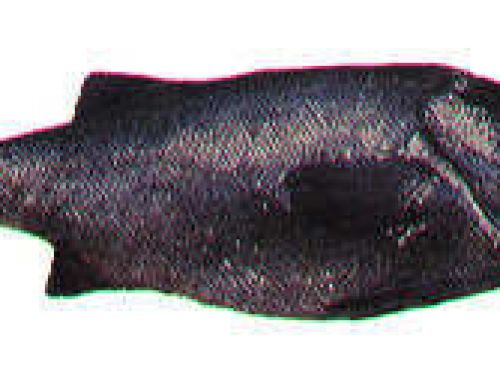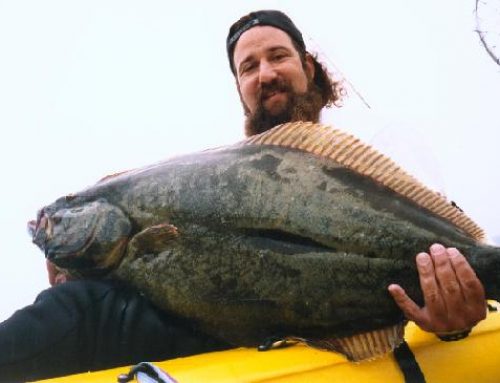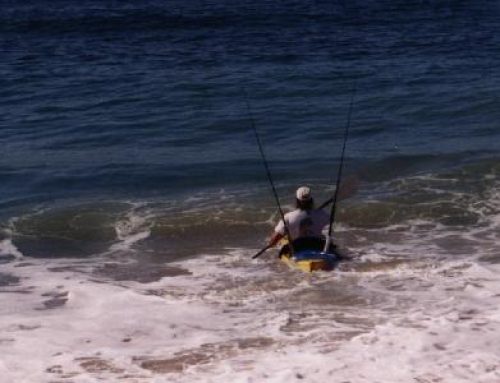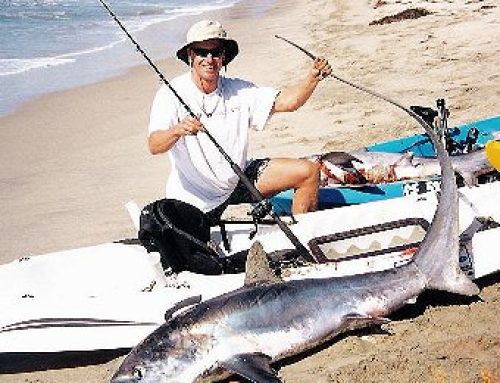by Jon Schwartz
Without a doubt, roosterfish are in a class of their own. Their intricate array of feathered dorsal fins give them an unparalleled exotic look, and their proximity to shore puts the kayak angler in a perfect position target them. At times they roam alone, but just as often they swim in marauding packs with their feathers just above the water’s surface, darting around in waist deep water in search of schools of mullet, their favorite prey. No need to paddle out several hundred yards; these prized fish can be targeted within a stone’s throw of the beach, or less.
My first experience with roosters was with one of the legendary pangueros of the East Cape, a man named Indio (whose real name, truth be known, is Marguerite, but don’t tell him I told you that). At the Sea of Cortez’s East Cape, the roosters’ favorite haunt is a stretch of beach just outside of paddling distance from Rancho Leonero, so we decided to put my rental kayak in the panga and transport it over to this area, known as the lighthouse. I launched my kayak in the shallows with a rod baited up with a sardine (no mullet were available), and I began a slow paddle along the shore. After awhile, a school of roosters approached. The sight of them made the hair stand up on my neck. Their movements set them apart from other fish. These fish did not lurk and wait; they moved aggressively and with a sense of urgency and purpose. They barged into the area, scanning quickly for prey, like DEA agents turning over an apartment in a raid. Their stripes and feathers were clearly visible in the crystal clear water.
 The thing about fishing for these fish is that, unlike most other species, you are put almost face to face with them, due to how they haunt the shallow clear water that you are gliding through. You can see how they hunt. The stealth of the kayak provides the kayak angler with just enough distance to get right next to the rooster without spooking the fish. As I waited for a strike, my heart raced. I grew impatient and reeled in the bait, and then tossed it at the school when they passed by again. This time, instead of passing the bait up, they scattered as if I had thrown a brick into their midst. I was definitely doing something wrong, but what? What kind of fish scatters when you toss them a bait?
The thing about fishing for these fish is that, unlike most other species, you are put almost face to face with them, due to how they haunt the shallow clear water that you are gliding through. You can see how they hunt. The stealth of the kayak provides the kayak angler with just enough distance to get right next to the rooster without spooking the fish. As I waited for a strike, my heart raced. I grew impatient and reeled in the bait, and then tossed it at the school when they passed by again. This time, instead of passing the bait up, they scattered as if I had thrown a brick into their midst. I was definitely doing something wrong, but what? What kind of fish scatters when you toss them a bait?
The rest of my 5 day stay consisted of more of the same. As the frustration mounted, my heart sank and I began to get more desperate. On the last day of the trip, Indio and I were motoring my kayak back to the Ranch from the lighthouse when he swung the boat around in a U-turn so sudden and tight that I froze. “Roosties! Roosties! Big Ones! Seventy, eighty pounds!” Having carried me around to all the hotspots in the area for several days in a row with no luck, Indio had begun to feel almost as forlorn as me. We launched my kayak. I took a baited rod, and slowly let the mullet drift back into the school of roosters, and let me tell you, these fish were huge. Even from 50 yards away, their gleaming striped backs, which were protruding out of the water, looked unbelievably massive. My eyes bulged out of their sockets as I craned my neck around to stare at them, praying for a strike. Finally my time had come!
The next thing I knew my bait began jumping into the air, just out of reach of the mouths of the roosters. They repeatedly crashed on the bait for at least a minute, but never actually swallowed it. I was sure that my line was going to start zinging at any minute, but it never happened, The school finally disappeared and as I reeled in my line I realized that my mullet was gone. “Pinche banditos!!” (Darned bandits!) muttered Indio.
Since then, I have had some lucky days with roosters, but more so than any other fish, I have had to pay my dues. I have learned several things about them. One is that they like for you to play hard to get with the bait. They like to see it slowly trolled, so they can feel like they are still hunting it. They can be unbelievably finicky, passing up a bait such as mullet because it has a few missing scales or a slight bruise. In addition, they can mouth the baits forever and spit them out just as you are readying to set the hook.
 The next time I returned to Rancho Leonero, I decided to launch from the beach myself with no panga support. This time I thought I was prepared. I had brought down a bait tank that I fashioned out of a small cooler. You never know what the bait is going to be at the Ranch. Sometimes there is plenty of mullet in the 7-10” range, perfect for big roosters, and sometimes the bait is small 3” sardines. Mullet are hands down the best bait for roosters, but they bruise easily and don’t keep well in a small bait tank like I had brought. Luckilly this time the bait was sardines, and I was able to load up on them when I paddled up to them men who sell bait out of their flooded panga just offshore.
The next time I returned to Rancho Leonero, I decided to launch from the beach myself with no panga support. This time I thought I was prepared. I had brought down a bait tank that I fashioned out of a small cooler. You never know what the bait is going to be at the Ranch. Sometimes there is plenty of mullet in the 7-10” range, perfect for big roosters, and sometimes the bait is small 3” sardines. Mullet are hands down the best bait for roosters, but they bruise easily and don’t keep well in a small bait tank like I had brought. Luckilly this time the bait was sardines, and I was able to load up on them when I paddled up to them men who sell bait out of their flooded panga just offshore.
At this time there was a marlin tournament in the area, and the boats were desperately maneuvering to line up at the bait boat. The local men selling bait had taken a liking to me, and waved me in between the smoke belching cruisers. “Sink that canoe!!” one of the guests barked, only half jokingly. I knew they were bitter as many of them had trolled all day the day before without a strike. I loaded up on sardines, pinned one on a circle hook, and began paddling away. Before I was 30 feet away, my reel began screaming and I locked down on. “He’s already hooked up!” someone complained. The fish turned out to be a ladyfish of about 8 pounds, which I landed and released in front of the astonished crowd of power boaters.
So many people go to the East Cape with plans of covering a lot of ground, well offshore, when the fact is, many of the best fish, including big jacks, roosters, dorado, and pargo, can all be landed within yards of shore, provided the water temperature is high and the water is blue. Many of these fish congregate at the site where the bait is bought, just offshore, waiting for the extra bait to fall into the water. The smart kayaker will be prepared for this and pin baits on as soon as possible. I’ve kicked myself for not being ready as dorado circle my kayak twenty yards offshore at 7:30 am, eyeing me as they circle my yak, waiting patiently for me to throw a cheap piece of squid that I neglected to tie on.
In any case, I paddled south into the light winds, and tried to get as far as I could before the winds picked up, which usually happens about 10:00 am. I got about 300 yards down the beach when I realized that my bait tank wasn’t circulating enough water to keep the ‘dines alive, and about half of them had perished already! I took the remaining live ones, and put most of them in a plano bait bucket that I had brought down. I pinned on two sardines on a small ringed circle hook, lines let out about three feet from the side of the yak. Needlefish abound in the shallows there and they will quickly eat all of your bait if you simply let your bait swim well behind your yak, but if you keep the bait close enough to you, the needles won’t approach. Then, when you see a school of baitfish being chased or the feathers of a rooster appear, you can quickly let out one of your baits, and the rooster or jack or pargo will swoop down on the offering.
This is exactly what I did. I got down to a favorite site about a half mile down the beach where there is a bunch of structure, and sure enough, I saw a school of sardines jumping out of the water in unison. I quickly let out the line on my lever drag reel loaded with 25 pound test and within seconds, I was onto my rooster with no panga support! The fish fought intelligently, first running straight away, then down, then changing directions. Just when I thought I had it, it took off for another set of runs. It wasn’t huge, maybe 15 pounds, but I was ecstatic that I was able to land this fish all on my own. When the bait dies quickly and the fish are finicky, the wind picks up, and the temperature is 95 degrees with 80 percent humidity, just getting 2 or three live baits a mile down the beach is an accomplishment. I kept on my course, staying within 20 feet of shore, and was struck again, this time by what turned out to be a 15 pound jack crevalle. On the way back, I was able to land one more rooster, for a total of three, and be back at the beach by 11:00!
O ne other rooster experience I’d like to relate occurred at the lighthouse as well. This time I had gotten my other favorite panguero, Rene, to take me there. We had maybe five mullet. He dropped me off in my kayak about 50 yards offshore, and I began to paddle around, one bait about 40 yards behind, and one bait about ten yards behind. I began circling the area, and noticed what appeared to be an oil slick on the water. This saddened me. How could this happen here in paradise? But I watched Rene, and he was watching the slick too, not with a look of disappointment, but of intense interest. I got the feeling that I should give the slick a second look, and when I got within 10 yards of the slick I found that the “slick” was actually a giant school of cubera snapper, swirling in such numbers that the sea had turned a dark reddish-brown! Unfortunately I was unable to entice any of the twenty pounders to strike. I’ve since learned that when a school is this large and packed together this closely, be it jacks, pargos or snappers, the fish are often simply not in eating mode.
ne other rooster experience I’d like to relate occurred at the lighthouse as well. This time I had gotten my other favorite panguero, Rene, to take me there. We had maybe five mullet. He dropped me off in my kayak about 50 yards offshore, and I began to paddle around, one bait about 40 yards behind, and one bait about ten yards behind. I began circling the area, and noticed what appeared to be an oil slick on the water. This saddened me. How could this happen here in paradise? But I watched Rene, and he was watching the slick too, not with a look of disappointment, but of intense interest. I got the feeling that I should give the slick a second look, and when I got within 10 yards of the slick I found that the “slick” was actually a giant school of cubera snapper, swirling in such numbers that the sea had turned a dark reddish-brown! Unfortunately I was unable to entice any of the twenty pounders to strike. I’ve since learned that when a school is this large and packed together this closely, be it jacks, pargos or snappers, the fish are often simply not in eating mode.
I continued paddling around the area, and about ten minutes later, my reel made the sweet high pitched screem that I had been waiting for. I waited till I couldn’t bear the suspense, slowly tightened the drag, my rod doubled over, and my yak spun around immediately towards the fish. Game on!! The fish immediately dove deep, and I was stunned at how much line it took. The water gets very deep right off of the beach, so you sit there, 50 yards off the beach, while your fish peels and peels line and you’re wondering, how deep can it go?
What ensued was one of the most memorable battles I’ve ever enjoyed. I had a 25 pound setup, and this fish put my equipment to the test. I am still amazed at how the reel held up. I was so worried about losing the fish that I kept grinding on the crank, even though I was gaining no line. Rene followed me around as the fish pulled me all over the place, and I kept looking at Rene, asking him, what could this possibly be? “Grande Rooster!” he said. C’mon, how could a rooster do this? The fish towed me at will and dove for the first 30 minutes, and then surfaced briefly, just long enough for me to see his magnificent body. It was a truly huge rooster. I screamed and my eyes bulged out.
As soon as his eyes met mine he dove again and the battle lasted for another 15 minutes. Finally, he came alongside of my yak, and I hoisted him for a picture. At this point I was within ten yards of the beach. Right after Rene snapped the last shot, he yelled, “Watch out!” and I was swamped by a wave in the shorebreak. In an instant my yak and gear were floating upside down, and the rooster was floating belly up next to me. It was either revive the fish or get the yak and gear, and I elected to revive the fish. I grabbed his tail, and as I swam behind him, I pushed him in front of me. When I did this, he raised his feathers and started moving slowly. His response encouraged me and I continued to push him along, although I quickly became exhausted from all the kicking necessary to keep a steady pace. Luckilly I had my PFD on, so I was never in any danger. I kept the rescue effort up as long as I could. Rene would have swooped in to grab the fish and revive him by pulling him alongside his panga as he slowly motored along, but he couldn’t risk getting to close to the shorebreak, so I was the fish’s only hope.
After awhile I became so exhausted that I couldn’t swim anymore. I had thought that the rooster would now be able to swim independently, but when I let go of him, he went belly up, so I swam him onto the beach and tried to revive him in knee deep water by running him along the shore. It was with great sadness 15 minutes later that I had to come to the reality that the fish wasn’t going to make it. I felt guilty. At this point my yak was lodged upside down in the sand with one the rods wedged in the sand like the obstacles on the beaches of Normandy. The other rod was lost. I put the fish in the yak, and since I had lost the paddle long ago, I tried to push the yak through the shorebreak. Eventually I had to get in, swim up the face of a wave, and push the yak over top of the wave, and then swim to the yak. Finally I kicked the yak and I out to where Rene was waiting for me. Rene took hold of the yak, I climbed over the side of the yak, and collapsed, exhausted, in a heap on the floor of the boat.
 What I have learned from this experience is that if the fish looks exhausted, it is best not to remove it from the water at all. In addition, I have switched to heavier tackle when targeting larger fish, as it enables me to get them up before they are completely spent. When I returned to the beach, I brought the fish to the fillet table and met up with my friend Dennis Spike. I told him how badly I felt for causing the fish’s demise, and he told me that I had done my best, and that sometimes, despite our best intentions, things like this happen. Although I had heard that roosters are almost inedible, I filleted the fish myself and brought every last ounce of the dark purplish meat back to San Diego, where I vowed to eat it all, lest the fish’s death go in vain.
What I have learned from this experience is that if the fish looks exhausted, it is best not to remove it from the water at all. In addition, I have switched to heavier tackle when targeting larger fish, as it enables me to get them up before they are completely spent. When I returned to the beach, I brought the fish to the fillet table and met up with my friend Dennis Spike. I told him how badly I felt for causing the fish’s demise, and he told me that I had done my best, and that sometimes, despite our best intentions, things like this happen. Although I had heard that roosters are almost inedible, I filleted the fish myself and brought every last ounce of the dark purplish meat back to San Diego, where I vowed to eat it all, lest the fish’s death go in vain.
What I had heard was true. The meat is barely edible. It looks like beef heart and has the consistency of shoe leather. Fortunately, my Mexican wife, who grew up dirt poor in the tiny country town of Areo de Rosales, is well versed in the art of making the most out of the least, and we were able to make some worth and meaning out of the wondrous fish’s ultimate sacrifice.
What I have learned from this experience is that if the fish looks exhausted, it is best not to remove it from the water at all. In addition, I have switched to heavier tackle when targeting larger fish, as it enables me to get them up before they are completely spent. When I returned to the beach, I brought the fish to the fillet table and met up with my friend Dennis Spike. I told him how badly I felt for causing the fish’s demise, and he told me that I had done my best, and that sometimes, despite our best intentions, things like this happen. Although I had heard that roosters are almost inedible, I filleted the fish myself and brought every last ounce of the dark purplish meat back to San Diego, where I vowed to eat it all, lest the fish’s death go in vain.
What I had heard was true. The meat is barely edible. It looks like beef heart and has the consistency of shoe leather. Fortunately, my Mexican wife, who grew up dirt poor in the tiny country town of Areo de Rosales, is well versed in the art of making the most out of the least, and we were able to make some worth and meaning out of the wondrous fish’s ultimate sacrifice.






You must be logged in to post a comment.